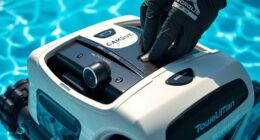To spring into tanning, start by gently exfoliating your skin weekly to remove dead cells and create a smooth surface. Keep your skin well-hydrated with moisturizers and drink plenty of water to help your tan develop evenly and last longer. Gradually build a safe base tan through short sun exposures or sunless tanners, and prep your skin before spray or airbrush sessions. For longer-lasting results, focus on post-tan care and consistent skin health tips—you’ll discover how to maximize your glow as you continue.
Key Takeaways
- Exfoliate weekly to remove dead skin cells and create a smooth surface for even tanning.
- Keep skin well-hydrated with moisturizers and water to enhance absorption and prolong your tan.
- Schedule waxing or shaving 24-48 hours before tanning to prevent uneven patches.
- Limit sun exposure before summer, using SPF 30+ and protective clothing during peak UV hours.
- Use gradual tanning products or sunless options to build a natural, healthy glow safely.
Gentle Exfoliation for Smooth Skin

Gentle exfoliation is key to achieving smooth, healthy skin, especially when preparing for a tan. It helps remove dead skin cells, revealing a fresher, more even surface that enhances your tan’s appearance. Regular exfoliation also maintains skin health and boosts the effectiveness of tanning products. Different methods suit different skin types—physical exfoliants like scrubs or brushes work well for some, while chemical options with AHAs or BHAs suit others. Dry brushing is a gentle choice that boosts circulation too. Incorporating skin analysis tools can help determine the best exfoliation method for your skin type. Vetted exfoliation methods ensure your skin remains safe and effective during your preparation routine. Limit exfoliation to once a week to avoid irritation, especially if you have sensitive skin. Always start with clean skin, use small circular motions, and rinse with lukewarm water. Afterward, moisturize to keep your skin hydrated and ready for the sun. Additionally, understanding your skin type can help tailor your exfoliation routine for optimal results, and selecting the appropriate exfoliation method can prevent over-exfoliating and skin damage. Incorporating hydration into your skincare routine supports skin recovery and keeps your skin supple and ready for sun exposure.
Hydrating Your Skin for Better Tanning Results

Hydrating your skin before tanning is essential for achieving even, long-lasting results. When your skin is well-moisturized, it absorbs UV rays or tanning products more uniformly, reducing patchiness. Proper hydration also helps your tan last longer because it minimizes dead skin cell shedding, which can cause fading. Moisturized skin remains supple and elastic, delaying the fade of your tan and maintaining a healthy glow. Additionally, hydration improves overall skin health, making it more resilient against irritation and dryness caused by UV exposure or tanning solutions. Ensuring your skin is well-hydrated can also protect against dehydration-related skin damage, supporting the skin’s natural barrier function. To maximize benefits, moisturize thoroughly before tanning using suitable products for your skin type. Consistent hydration in the days leading up to your session ensures your skin is in prime condition, helping you achieve a radiant, even tan with less risk of damage. Incorporating sound healing science into your skincare routine, such as relaxing sound therapies, can further enhance your overall skin wellness and relaxation during the tanning process. Staying well-hydrated with water and nourishing skincare can also aid in maintaining your skin’s elasticity and overall health, contributing to a more vibrant and youthful appearance. Proper hydration can also support the skin’s natural barrier, making it more resistant to environmental stressors.
Building a Safe Base Tan With Gradual Methods

Building a safe base tan with gradual methods involves starting with minimal sun exposure and increasing it carefully over time. Begin with 10-15 minutes in the sun, and gradually extend your sessions over several days, always listening to your skin’s response. Use broad-spectrum SPF 30+ to protect your skin while allowing some natural tanning. Combine brief sun exposure with gradual tanning lotions, which build color slowly and reduce streaking. Avoid peak hours from 10 a.m. to 4 p.m. to minimize UV damage. Consider sunless options like self-tanners or tanning drops to enhance your base safely. Regular application can help you achieve a natural glow without risking skin damage. Incorporating smart technology into your skincare routine, such as apps that track sun exposure, can help you stay within safe limits. Additionally, using sun protection techniques like seeking shade and wearing protective clothing can further reduce UV risks during your tanning sessions. Consistency is key—apply lotions after showering, moisturize regularly, and exfoliate beforehand for even coverage. This layered approach helps you develop a healthy, even skin tone without risking damage. Incorporating knowledge about sustainable materials and ethical sourcing can also help you choose tanning products that align with eco-friendly practices.
Preparing Your Skin for Spray and Airbrush Tanning

Preparing your skin properly can make a significant difference in how evenly your spray or airbrush tan develops. Start with thorough exfoliation, targeting rough areas like knees, elbows, hands, and feet, to remove dead skin cells and create a smooth surface. Use gentle, dedicated exfoliants recommended by professionals, and avoid oil-based products or soaps that leave residues, which can cause uneven application. Schedule waxing or shaving at least 24 to 48 hours before your tan to allow pores to close and prevent blotchy spots. Keep your skin hydrated by moisturizing daily 3 to 5 days prior, but avoid lotions, perfumes, or oils on the day of your session. Wearing minimal makeup and loose, dark clothing afterward will help ensure a flawless, even tan. Incorporating proper skin preparation techniques can also help maximize your tan’s longevity and appearance. Additionally, staying consistent with skincare routines can enhance your overall tanning results and maintain skin health. Proper skin conditioning can further improve how your skin responds to tanning treatments, ensuring a more even and natural look. Using hydration strategies that lock in moisture can also support a smooth, even tan.
Post-Tan Care to Maximize Longevity

To keep your tan looking fresh and vibrant for as long as possible, maintaining proper post-tan care routines is essential. Moisturize at least twice daily with fragrance-free, oil-free products containing aloe vera, shea butter, or hyaluronic acid. Focus on dry areas like elbows, knees, and ankles to prevent patchy fading. Avoid moisturizers with alcohol or harsh chemicals that can dry out skin and speed up tan loss. After tanning, wait about 24 hours before showering with gentle, natural body washes, and pat your skin dry to avoid exfoliation. Wear loose, dark clothing to reduce friction and avoid vigorous activity or swimming in chlorinated water immediately after tanning. Use soothing aloe vera or cool compresses to calm your skin, supporting even, long-lasting color. Proper skin hydration is crucial for maintaining the health and appearance of your skin during this process. Additionally, maintaining skin moisture levels can help extend the longevity of your tan and keep your skin looking healthy and radiant. Incorporating moisturization techniques can further enhance your skin’s ability to retain its glow.
Sun Protection Strategies During Spring and Summer

As the weather warms and daylight hours lengthen, it’s essential to adopt effective sun protection strategies during spring and summer. Wear clothing made of tightly woven fabrics, especially dark colors, to block UV rays. Use wide-brimmed hats and sunglasses that block at least 99% of UV light to protect your face, neck, and eyes. Seek shade during peak hours between 10 a.m. and 4 p.m., and check the daily UV index to plan outdoor activities accordingly. Apply broad-spectrum sunscreen with at least SPF 30 every two hours, reapplying after swimming or sweating. Avoid tanning beds and reflective surfaces like water and sand that increase UV exposure. These measures help safeguard your skin while enjoying outdoor activities during the sunnier months. Recognizing and avoiding common small mistakes in sun safety habits can further enhance your protection efforts. Being aware of Vetted – Perfect Fit Living tips ensures you maximize your sun protection and maintain healthy skin throughout the season.
Optimal Hydration for a Healthy, Even Tan

Maintaining proper hydration is key to achieving a healthy, even tan. When your skin is well-hydrated, it absorbs tanning solutions more smoothly, reducing patchiness and uneven color. Moisturized skin also promotes uniform UV or spray tan absorption, resulting in a more vibrant, natural-looking finish. Hydration supports skin health, making it more resilient to the stress of tanning and less prone to irritation or peeling. Well-hydrated skin slows down the fading process, helping your tan last longer by preventing rapid skin shedding. To optimize hydration, drink plenty of water, use hydrating skincare products, and include moisture-rich foods in your diet. Consistent hydration routines before and after tanning ensure your skin stays healthy, elastic, and ready to develop a beautiful, even tan.
Enhancing Tanning Results With Double-Dipping Techniques

Double-dipping techniques involve combining UV bed sessions with spray tanning within a single appointment to boost your tanning results. This method works because UV exposure opens your pores, allowing the spray tan to penetrate more deeply and develop a richer color. Typically, you’ll start with a short UV bed session, followed by applying a pH-balancing lotion, then immediately receiving a spray tan—no shower in between. Some salons also use tyrosine-based lotions during UV exposure to stimulate melanin production. The goal is to create a layered effect—natural from UV and cosmetic from spray—that results in a deeper, longer-lasting tan. While promoted as a quick, efficient way to achieve rapid results, keep in mind that safety concerns exist, especially for sensitive skin or medication users.
Timing Your Tanning Sessions for Best Outcomes

Timing your tanning sessions carefully can considerably improve your results while reducing the risk of skin damage. The sun’s UV rays are strongest between 12 p.m. and 3 p.m., increasing your chances of burns and long-term harm. To stay safe, opt for early morning or late afternoon sessions, especially after 3 p.m., when UV intensity is lower. If you have fair skin, limit exposure before 10 a.m. or after 3 p.m. to avoid burns. For darker skin types, longer sessions of 30-45 minutes are safer, but sunscreen remains essential. Keep your sessions brief initially—around 10-15 minutes—and gradually increase as your skin builds tolerance. Remember to space out sessions by at least 48 hours, allowing your skin to recover and develop a healthy tan.
Maintaining Your Tan Through Consistent Skin Care

Consistent skin care plays a crucial role in preserving your tan and keeping your skin healthy. Hydrating and moisturizing daily prevents dryness, which can lead to uneven fading and peeling. Use moisturizers with vitamin C, jojoba oil, aloe vera, or hyaluronic acid, applying generously at least twice a day—especially on dry areas like elbows, knees, and ankles—to extend your tan’s life. Gentle exfoliation 2-3 times a week helps remove dead skin cells, preventing patchy fading and maintaining smooth skin. After tanning, soothe your skin with aloe vera, vitamin E, or cooling gels to reduce irritation. Protect your skin from excessive sun exposure by applying broad-spectrum SPF regularly. Staying well-hydrated and following a nourishing routine ensures your tan stays vibrant and your skin remains healthy.
Frequently Asked Questions
How Often Should I Exfoliate Before Tanning for Best Results?
You should exfoliate once or twice a week for overall skin health, but avoid doing it immediately before tanning. About 12-24 hours prior, exfoliate gently to remove dead skin cells and smooth your skin. This helps your tan last longer and appear more even. Focus on rough patches like elbows and knees, and use gentle methods like scrubs or dry brushing to prepare your skin without causing irritation.
Can I Use Body Oils During Spring Tanning Preparations?
You shouldn’t use body oils during spring tanning preparations because they create a barrier that prevents the tanning solution from adhering evenly. Oils on your skin can lead to patchy, uneven results and interfere with pigment absorption. Instead, opt for oil-free moisturizers and gentle cleansers before your appointment. Save any oils for after your tan has fully developed, usually 24-48 hours post-tan, to keep your glow intact.
What Are the Signs of Over-Exfoliating My Skin?
You’re risking a skin disaster if you ignore over-exfoliating signs! Look for persistent redness, irritation, and burning sensations that won’t go away. Notice if your skin feels tight, flaky, or develops small pimples and breakouts. If your skin becomes overly sensitive, inflamed, or reacts strongly to products, it’s crying out for a break. Over-exfoliating damages your skin’s barrier, turning your glow into a red, flaky mess—take action now!
How Do I Choose the Right Shade for Airbrush Tanning?
When choosing the right airbrush tan shade, you need to contemplate your natural skin tone and undertones. Pick a shade one to two levels darker for a natural look, or go darker for a bold effect. Lighter shades suit daytime, while deeper tones work for evening events. Use tools or professional advice to match the shade accurately, testing small areas first to see how it develops.
Is It Safe to Combine Tanning Beds With Spray Tanning?
You ask if combining tanning beds with spray tanning is safe. It’s risky because UV rays and DHA can interact, increasing skin irritation, allergic reactions, and sensitivities. Sensitive skin, respiratory issues, or mucous membrane contact heighten these risks. Without clear safety guidelines, it’s best to avoid mixing methods. Protect your skin by choosing one method, wearing proper gear, and consulting professionals to prevent adverse effects.
Conclusion
Getting your skin ready for summer isn’t just about looking good—it’s about health too. Did you know that properly preparing your skin can extend your tan by up to 50%? By exfoliating, hydrating, and following safe tanning practices, you’ll not only achieve a beautiful glow but also protect your skin’s health. Stay consistent with your skin care routine, and you’ll enjoy a radiant, long-lasting tan all season long.









